Shooting on KODAK film, DP Robbie Ryan BSC ISC used VistaVision to captivating effect on Yorgos Lanthimos' satirical sci-fi kidnap thriller 'Bugonia'
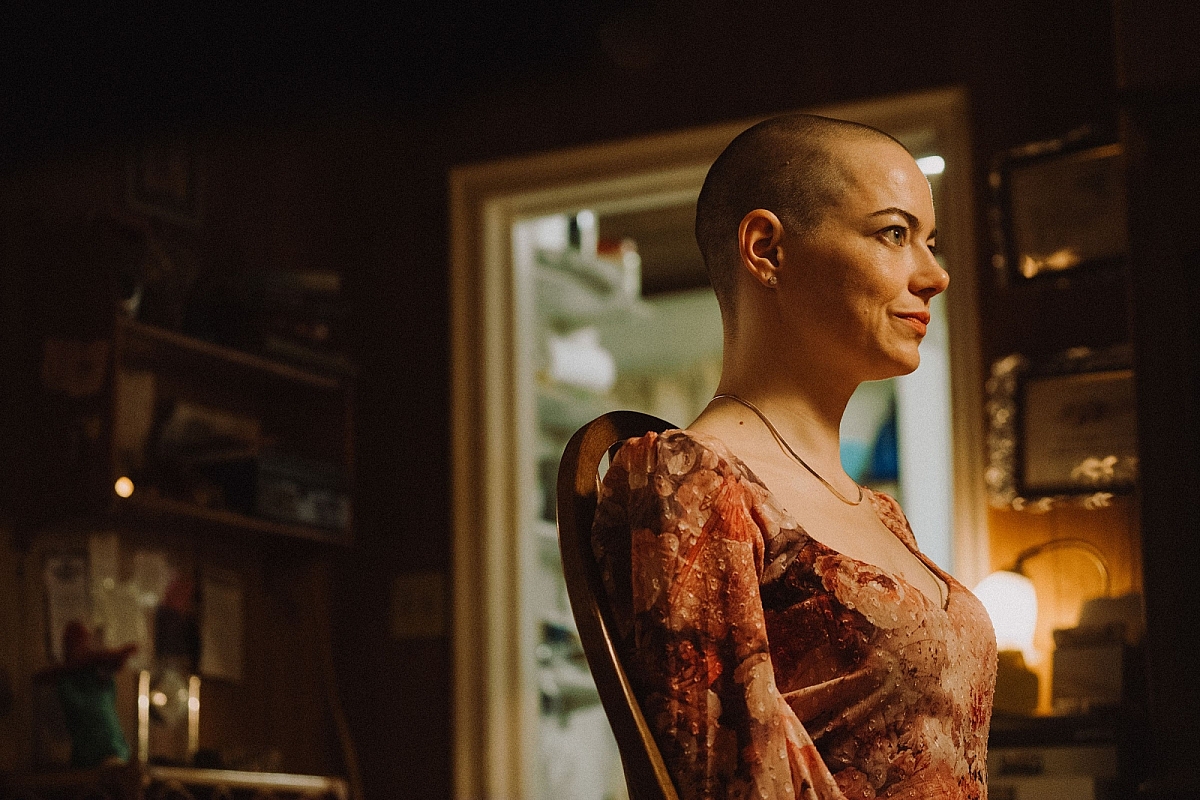
Emma Stone stars as Michelle in director Yorgos Lanthimos' BUGONIA, a Focus Features release. Credit: Atsushi Nishijima/Focus Features © 2025 All Rights Reserved.
Shooting on KODAK film, DP Robbie Ryan BSC ISC used VistaVision to captivating effect on Yorgos Lanthimos' satirical sci-fi kidnap thriller Bugonia, declaring himself to be "stunned by the results." The film is expected to feature prominently in the 2026 awards season.
Bugonia (whose title refers to an ancient Greek belief in the birth of bees from dead cows) follows Teddy (Jesse Plemons) and his impressionable younger cousin Don (Aidan Delbis), whose beehive colony in the meadow next to their decrepit rural home has begun to collapse.
Teddy, an internet conspiracy theorist, believes the problem has been caused by extra-terrestrials who have infiltrated and now covertly control humanity. To send a message to the aliens that humans are not to be toyed with, Teddy aims to capture one of the invaders he has identified in the form of Michelle Fuller (Emma Stone), the steamroller CEO of a local biomedical corporation, where he holds a menial job and whose opioid experiments have left his mother in a permanent coma. The pair duly make the abduction and begin interrogations in the confines of the dark and dingy basement, hoping to force an admission from the Andromedan invader, board her spaceship and return her to where she rightly belongs.
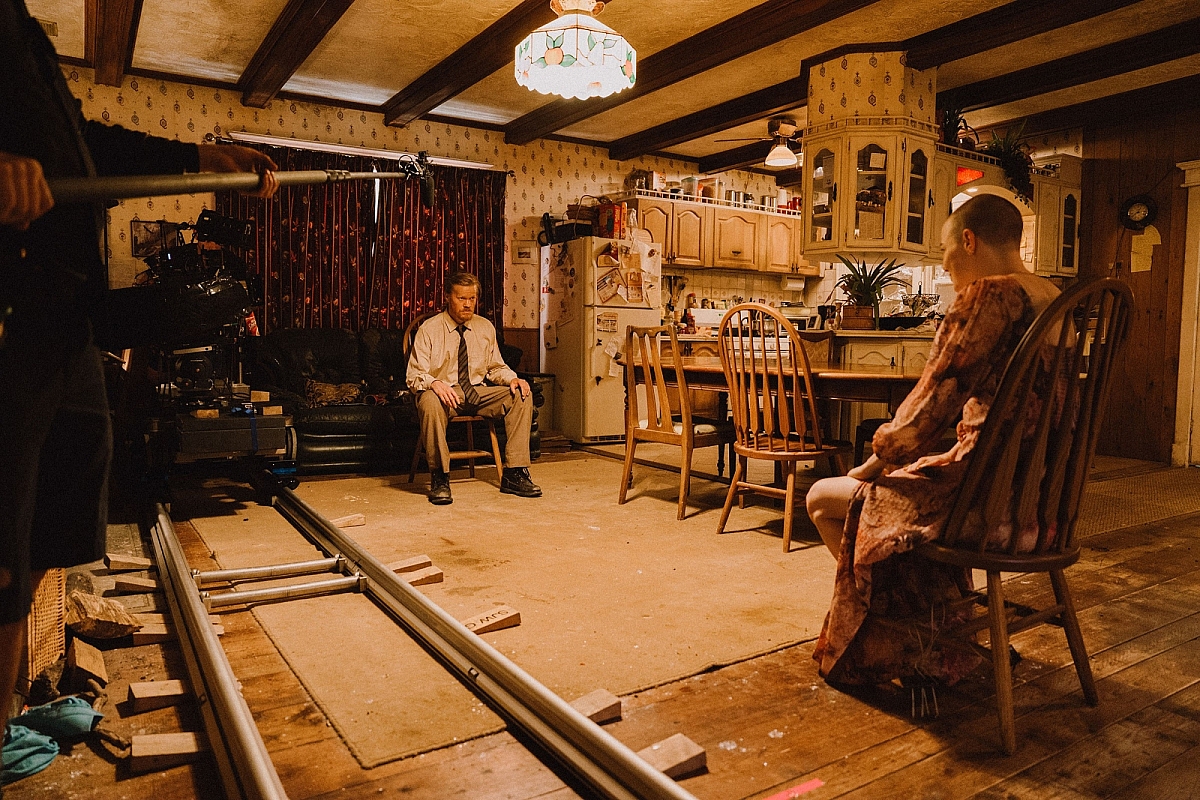
(L to R) Actors Jesse Plemons and Emma Stone during the production of director Yorgos Lanthimos' BUGONIA, a Focus Features release. Credit: Atsushi Nishijima/Focus Features © 2025 All Rights Reserved.
An international co-production between Ireland, South Korea and the US, Bugonia is an English-language remake of the South Korean black comedy sci-fi thriller Save the Green Planet! (2003, dir. Jang Joon-hwan, DP Hong Kyung-pyo), adapted by Will Tracy, with filmmaker Ari Aster among the producers.
After pre-release screenings at festivals worldwide, the movie earned rave reviews for the extraordinary power of its immersive visual treatment, along with Lanthimos' whip-smart exploration of themes surrounding corporate greed, extreme environmentalism, the ideological confrontation of paranoia versus power, and humanity's ability to overcome its failings.
The movie is Ryan's fourth feature collaboration with Lanthimos, following their work together on The Favourite (2018) and Poor Things (2023), both earning the DP Oscar nominations, and Kinds of Kindness (2024) – all shot on KODAK film.
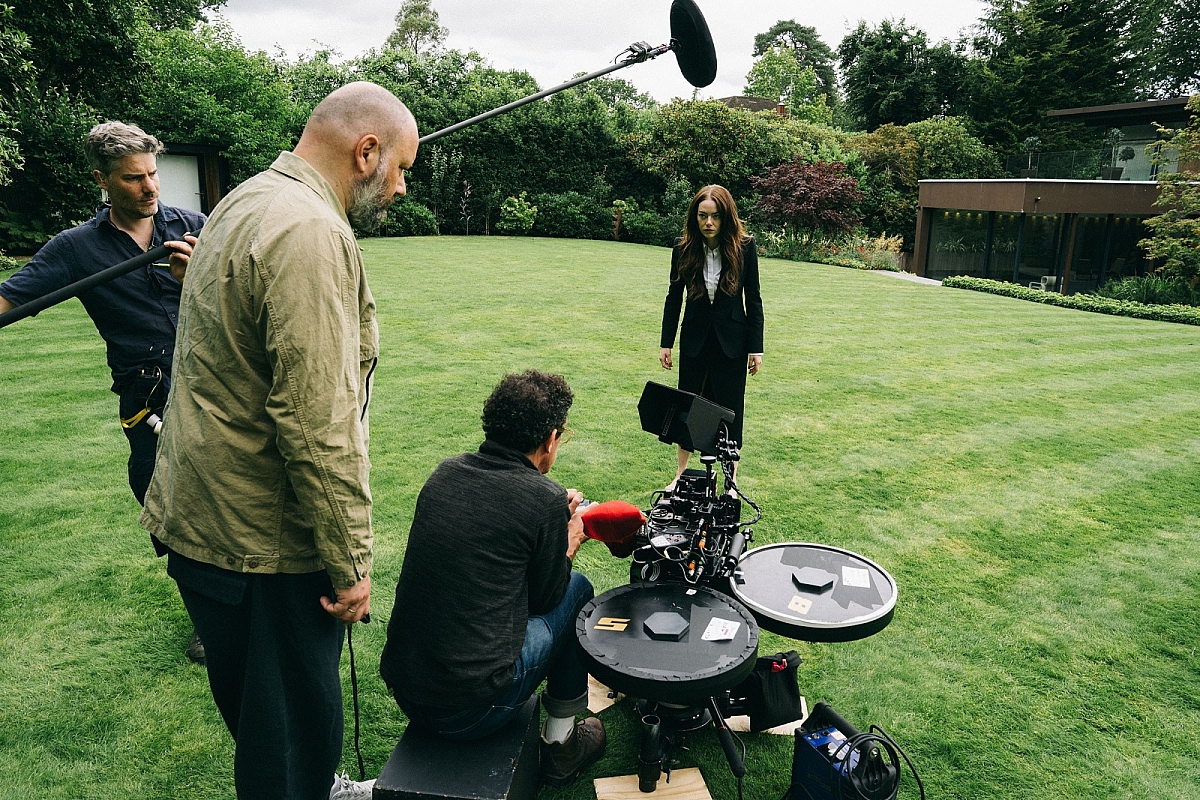
(L to R) Director Yorgos Lanthimos, director of photography Robbie Ryan and actor Emma Stone on the set of BUGONIA, a Focus Features release. Credit: Atsushi Nishijima/Focus Features © 2025 All Rights Reserved.
The Irish DP has an impressive and consistent track-record of shooting on 16mm and 35mm film with credits encompassing Andrea Arnold's Fish Tank (2009) and Wuthering Heights (2011), Ken Loach's The Angel's Share (2012) and I, Daniel Blake (2016), Billy O'Brien's I Am Not a Serial Killer (2016), Noah Baumbach's The Meyerowitz Stories (2017) and Marriage Story (2019), plus John Maclean's Tornado (2025).
Upon reading the script for Bugonia, Ryan says, "I was all in. There couldn't have been a more prescient time – of mad minds and mad ideas – to make a film with a wake-up call. Yorgos is a visionary, who is always eager to explore and try new things. We had used a VistaVision camera on Poor Things to shoot the flashback sequence in which Bella is reanimated, and he really loved the detailed and immersive result. When it came to making Bugonia, he felt VistaVision would be a great choice, and I was really keen to see how we might get that to work."
VistaVision is a high-resolution widescreen film format, developed by Paramount Pictures in 1954, to create a higher-quality visual experience that would compete against the rising popularity of television and lure audiences back into cinemas. Instead of running the film vertically through a standard 35mm camera, VistaVision cameras run 35mm horizontally, giving an 8-perf 1.5:1 frame, that has double the surface area of standard 35mm film, resulting in sharp and highly-detailed images with fine grain.
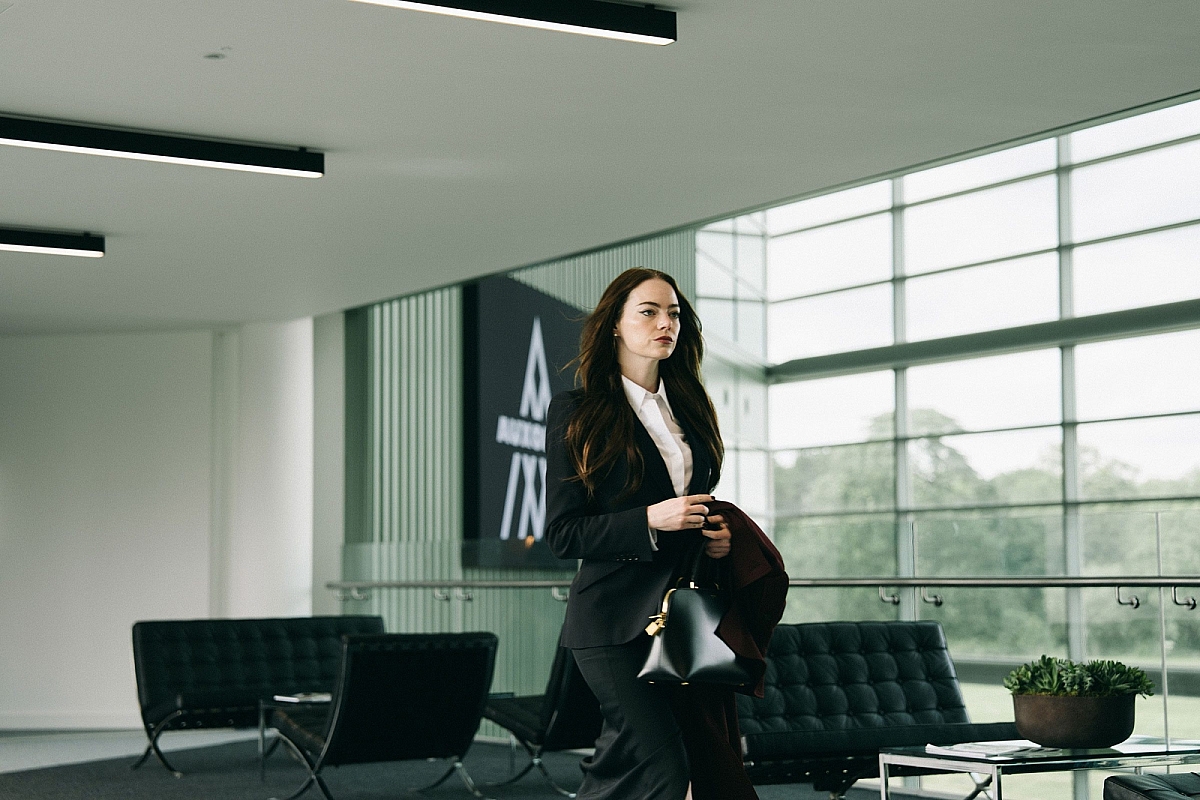
Emma Stone stars as Michelle in director Yorgos Lanthimos' BUGONIA, a Focus Features release. Credit: Atsushi Nishijima/Focus Features © 2025 All Rights Reserved.
White Christmas (1954) was the first feature to be shot using VistaVision and became the highest grossing film of the year, followed soon after by equally successful classics including Cecil B. DeMille's The Ten Commandments (1956) and Alfred Hitchcock's Vertigo (1958).
Although Paramount dropped the format in the early 1960s, due to refinements in Eastmancolor filmstocks, VistaVision's high resolution still made it attractive to filmmakers for VFX sequences in the Star Wars, Batman and Indiana Jones franchises.
In more recent times, VistaVision has made a notable comeback as the main production format on movies such as The Brutalist (2024, dir. Brady Corbett), which won three Academy Awards, including one for its cinematographer Lol Crawley BSC ASC, and with directors Paul Thomas Anderson and Lanthimos selecting it for their respective features One Battle After Another and Bugonia.
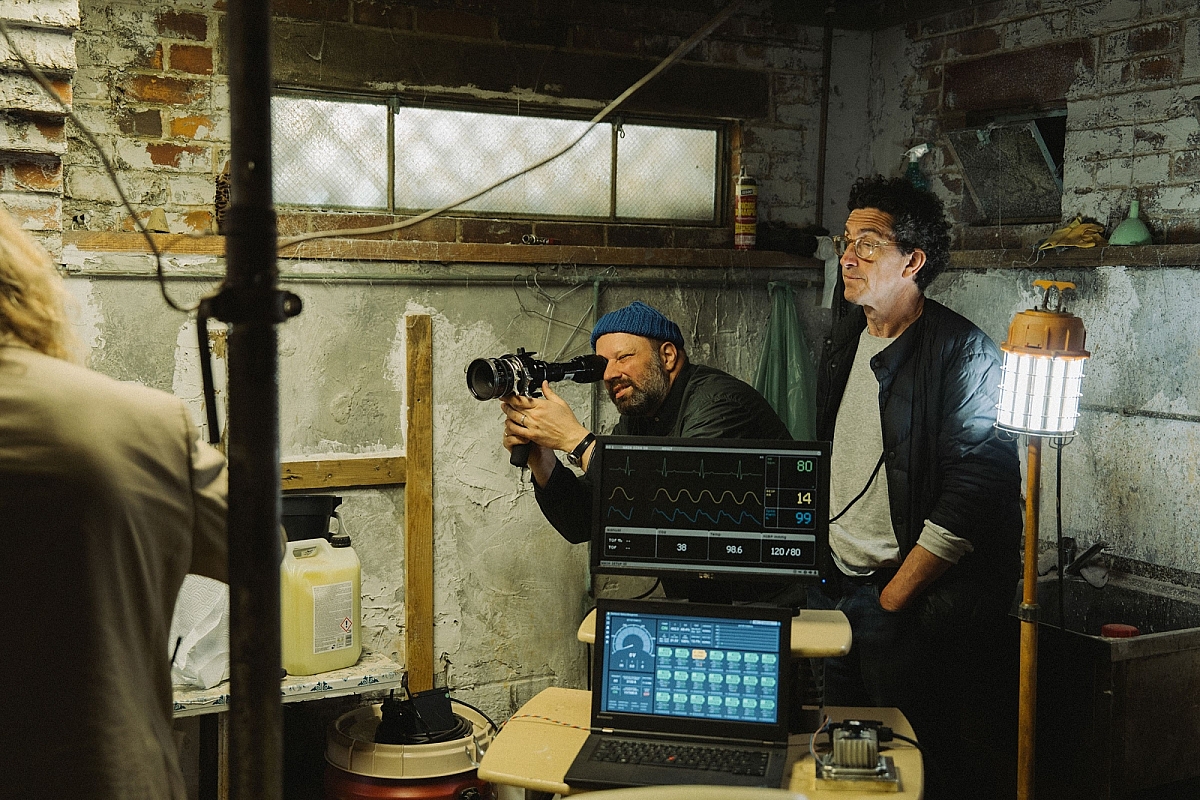
(L to R) Director Yorgos Lanthimos and director of photography Robbie Ryan during the production of BUGONIA, a Focus Features release. Credit: Atsushi Nishijima/Focus Features © 2025 All Rights Reserved.
"Yorgos is known for the distinct visual language he brings to each film. Whereas we'd gone for super-wide angles in The Favourite and Poor Things, the difference with this film was that he wanted the cinematography to focus more on portraiture. And what better way is there do portray the landscape of the face, than on a very beautiful, high-resolution format like VistaVision?"
Ryan remarks, "I have to admit that until we did Poor Things, I had never shot in VistaVision before and also didn't really know much about it, other than the beauty, grandeur and clarity of the images in films like The Searchers (1956, DP John Ford, DP Winton C Hoch ASC) and Vertigo (1959, DO Robert Burks ASX). So I really had some learning to do."
About a year before going into production on Bugonia, he duly tracked down Scott Smith and Marty Mueller, experts in IMAX and large-format camera restoration, who, as happenstance would have it, had recently been responsible for overhauling the Wilcam W11, the world's only 8-perf sync-sound VistaVision camera. They rebuilt it with new electronics, motors known as 'The Silencers,' plus modern features including a 2K video tap, optional 2,000-ft film magazines offering ten minutes of recording time, and a Panavision lens mount, available through Panavision in Woodland Hills, California.

(L to R) Emma Stone as Michelle, Aidan Delbis as Don and Jesse Plemons as Teddy in director Yorgos Lanthimos' BUGONIA, a Focus Features release. Credit: Atsushi Nishijima/Focus Features © 2025 All Rights Reserved.
"We employed a Beaumont VistaVision camera on Poor Things, but realizing it was pretty noisy, used it just for the non-sound-sync flashback sequence. By comparison the Wilcam W11 is much quieter and could therefore be more easily used for dialogue scenes.
"So we shot tests with the actors, and Yorgos was impressed by the luscious detail in the images. And despite the quirks and foibles that come with vintage equipment – like the camera jamming on whip-pans and the horizontal magazines being the size of two enormous pizzas that would make it interesting to maneuver around – he felt VistaVision was the perfect format for the film."
Regarding references, Ryan recounts, "I didn't really look at VistaVision films per se during prep. Rather Yorgos encouraged me to watch the work of Bill Douglas, particularly his trilogy – My Childhood (1972, DP Mick Campbell), My Ain Folk (1973, DP Gale Tattersall) and My Way Home (1978, DP Ray Orton) – which are deeply-rooted in Douglas' own life experiences, memories and childhood in a Scottish mining village. They're gems, with beautiful compositions, timed camera moves and rhythms in the editing that combine to create a unique emotional and visual language. If anything, our cinematographic style was influenced by all that."
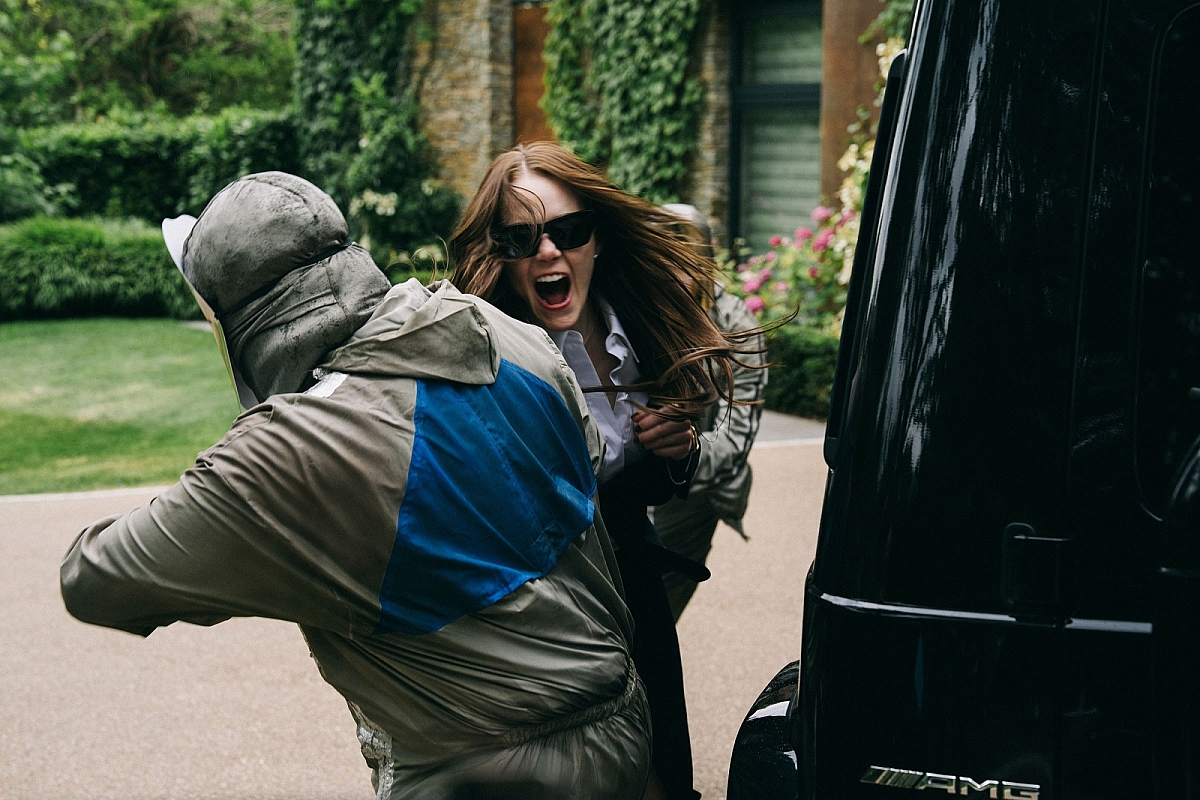
Emma Stone stars as Michelle in director Yorgos Lanthimos' BUGONIA, a Focus Features release. Credit: Atsushi Nishijima/Focus Features © 2025 All Rights Reserved.
While Bugonia is set in the US, it was largely shot in the UK. Filming took place between June and September 2024, over 47 shooting days. The first 39 days were spent amid 3,500 acres of mature beech woods and rolling pastures on the Culden Faw Estate, near Henley-on-Thames, England, where Teddy and Don's prairie-style home, including the basement, was constructed as an entire set, under the auspices of production designer James Price. Ryan says the location was a blessing in disguise, as he was able to moor his own 40-ft cruiser, the 'Mary Louise,' on the River Thames, and thereby avoid a lengthy commute from London every day.
After wrapping in the UK, the production spent eight days shooting at locations around Atlanta. Second unit filming, supervised by Daniel Wolfe as director and Harry Wheeler the DP, took place in London and Greece.
Supported by Panavision during production, Ryan deployed the Wilcam W11 for the movie's dialogue scenes, and a Beaumont camera for non-dialogue sequences. When it came to lenses, the DP liaised with Panavision's lens guru, Dan Sasaki, about a set of prototype optics. These offer a similar look to Panavision's legacy Super Speed glass, famously favored by Gordon Willis ASC, and were specially-developed to cover the VistaVision format for One Battle After Another, through collaboration between Sasaki and director Paul Thomas Anderson. After One Battle After Another had wrapped, and Ryan was prepping Bugonia, he opted to work with those same prototypes.

Stavros Halkias stars as Casey in director Yorgos Lanthimos' BUGONIA, a Focus Features release. Credit: Atsushi Nishijima/Focus Features © 2025 All Rights Reserved.
"Dan asked me how I wanted the image to feel, and my main request was for sharpness, partly because that's what Yorgos likes and partly because of the large 8-perf format. So, we ended up using the same ones that were used on One Battle After Another.
"As the film was very close-up on the actors, we used a lot of the shorter focal lengths, chiefly the 18mm, 21mm, 40mm and 50mm which are all T1.4, but went with longer-length 129mm T1.8 and 180mm T1.9 Panavision Primos on some occasions."
Ryan selected KODAK VISION3 250D 5207 for the basement scenes, KODAK VISION3 50D 5203 for day exteriors and KODAK VISION3 500T 5219 for low-light and night scenes. The dreamlike flashbacks alluding to Teddy's comatose mother were shot using KODAK DOUBLE-X 5222 35mm negative. Film processing was done at Cinelab, UK, with the final grade performed by Greg Fisher at Company3 in London.
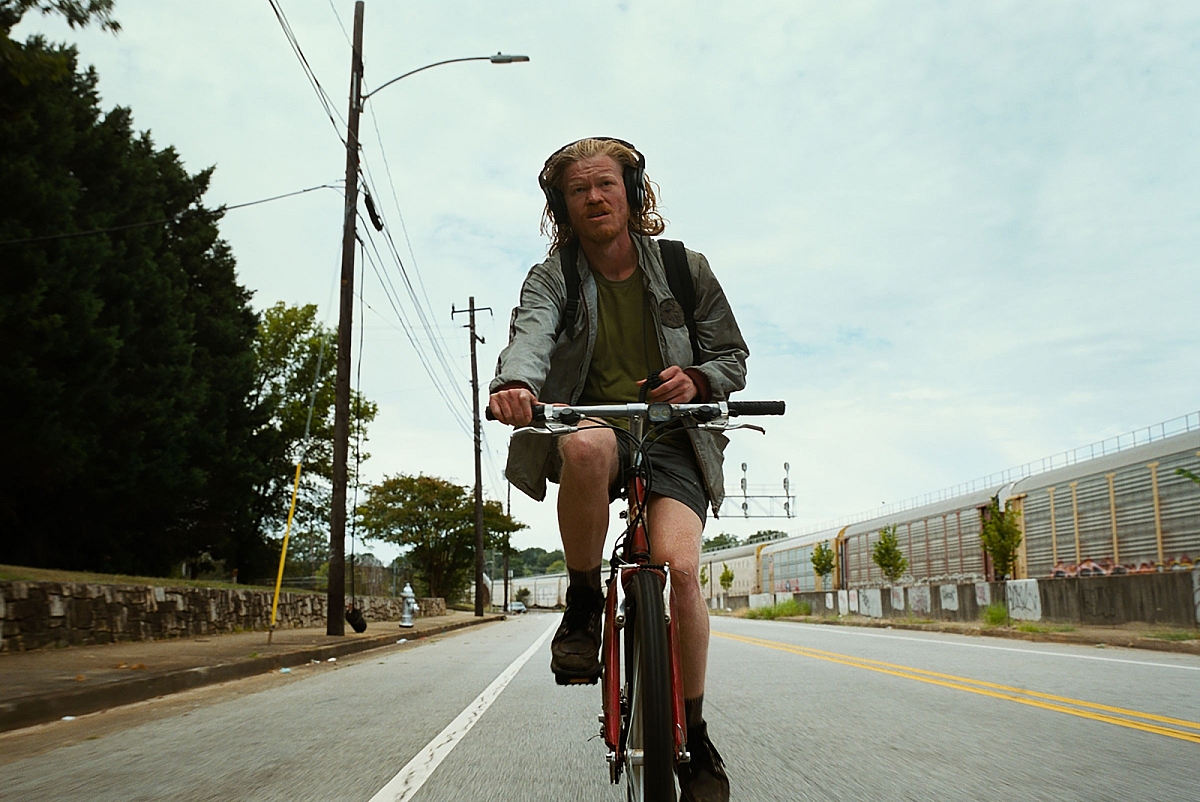
Jesse Plemons stars as Teddy in director Yorgos Lanthimos' BUGONIA, a Focus Features release. Credit: Courtesy of Focus Features © 2025 All Rights Reserved.
"I love shooting on Kodak. I know those stocks and how they perform really well. The biggest issue was choosing which stocks to get cut into 2,000-ft loads for the Wilcam W11. As it worked out, the 250D was our main workhorse, and if we were ever in danger of running low, it was easy to switch to 500T, as the two stocks marry together and you cannot see the join."
Ryan estimates that 90% of Bugonia was shot using VistaVision cameras. Mainly a single-camera shoot, Ryan operated the Wilcam W11 throughout production, supported by Olga Abramson on focus, with Matt Fisher working as Steadicam operator and wielding the Beaumont, aided by Cristina Cretu on focus. Brain Udoff worked as the VistaVision camera technician. As the noisier Beaumont was unsuitable as a B-camera for a small number of dialogue scenes, such as the kitchen/dinner sequence, a regular 35mm camera was introduced to provide the necessary coverage.
"Because of the unwieldy size and weight of the Wilcam W11, we shot on a Peewee dolly most of the time, sometimes with a three-axis stabilized Libra Head to ensure the shots were steady," Ryan recalls. For the car driving scenes, the camera was rigged to the car with Emma doing the driving herself for authenticity, rather than using a low-loader.
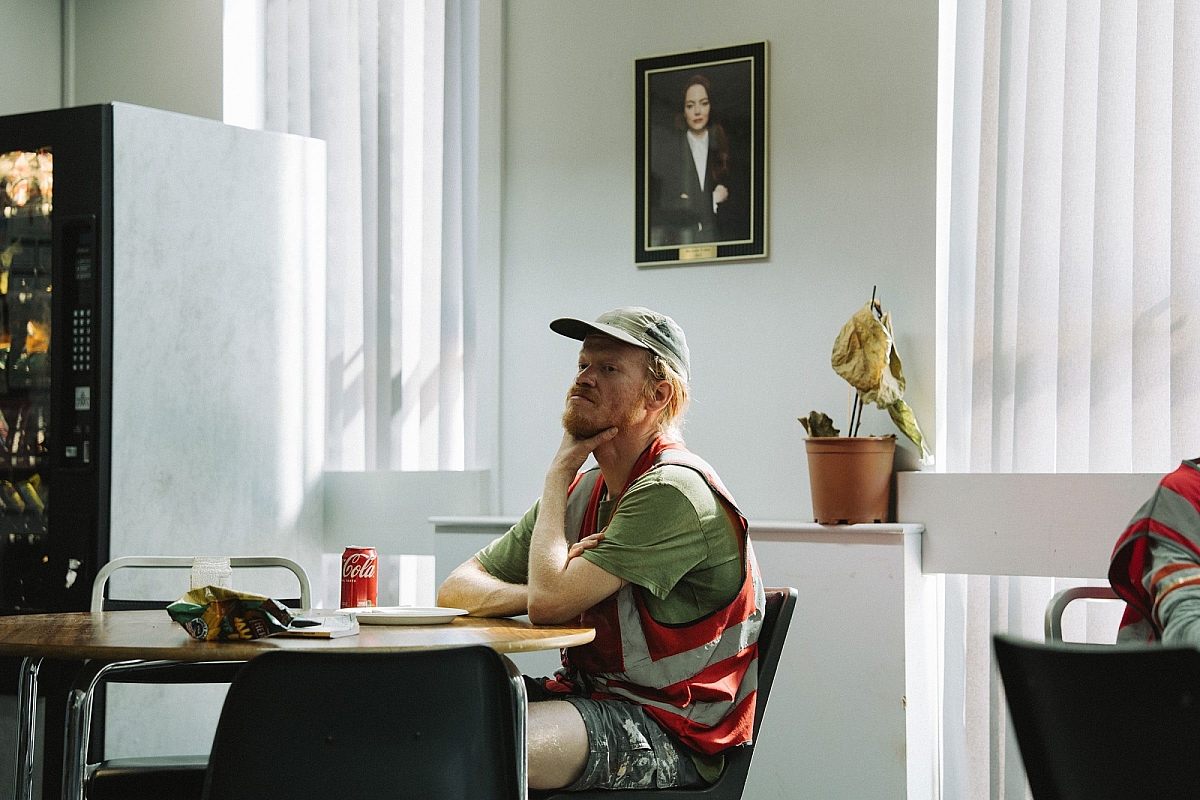
Jesse Plemons stars as Teddy in director Yorgos Lanthimos' BUGONIA, a Focus Features release. Credit: Atsushi Nishijima/Focus Features © 2025 All Rights Reserved.
"VistaVision cameras are not easy to work with, and I'm really proud of my camera team in making sure things ran smoothly without too many issues, and for generally keeping us up-to-speed."
Ryan's framing decision, during the basement interrogation scenes, is worthy of note, with the camera looking upwards at the protagonists to amplify the idea of incarceration and inquisition taking place in a dungeon-like environment.
"It's a strong angle, that's for sure. It sears those faces into your brain, and I loved how you can practically feel details like the stubbly bristles on Teddy's face," says Ryan. "As you can see in all of the films we've made together, Yorgos is not a fan of having the camera straight on at the same eye level as the actors, and the angles for the basement scenes really did help to convey a subterranean feeling."

(L to R) Aidan Delbis as Don and Jesse Plemons as Teddy in director Yorgos Lanthimos' BUGONIA, a Focus Features release. Credit: Atsushi Nishijima/Focus Features © 2025 All Rights Reserved.
One complication of shooting in VistaVision came with synchronizing the lighting to the cameras. As Ryan explains, "The main problem was the fact that the Wilcam W11 has a locked shutter-angle of 144°, which at standard 24fps, equates to a 1/60th of a second exposure time. This setting is commonly used in US production to eliminate flicker from artificial lights and computer monitors by synchronizing the camera's exposure with the 60Hz power supply frequency.
"As we're shooting in the UK, which has a 50Hz supply, this meant, my gaffer, Jonny Franklin, had to design the electrical power supply to match the camera. So along with making sure we had a generator capable of delivering 60Hz, he also had to wire the whole house and adapt the lights accordingly, too.
"It was a massive job that took a good couple of weeks alone. When it was done, however, Jonny had ensured that all of the lighting fixtures were networked together so that Nathan Porter, our lighting console operator, could dim a light up or down or dim at the touch of a button.
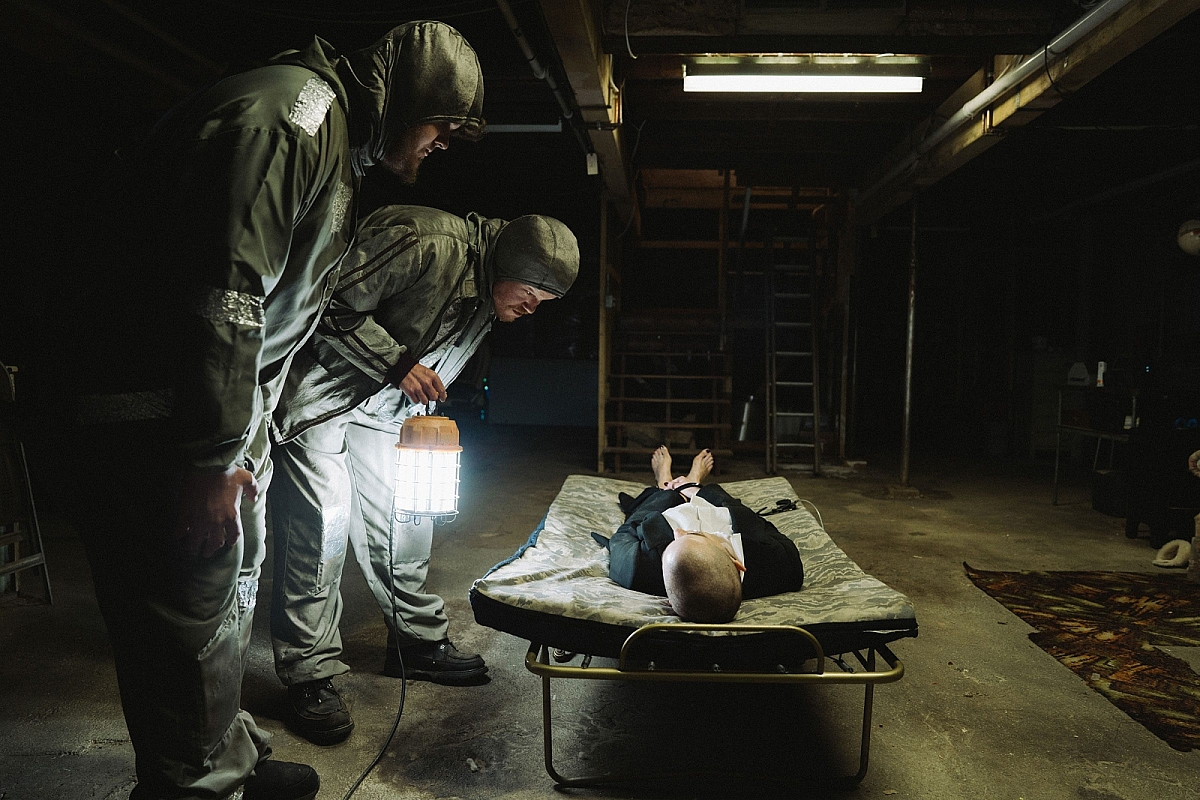
(L to R) Aidan Delbis as Don, Jesse Plemons as Teddy and Emma Stone as Michelle in director Yorgos Lanthimos' BUGONIA, a Focus Features release. Credit: Atsushi Nishijima/Focus Features © 2025 All Rights Reserved.
"I really enjoyed working with Jonny, who helped with the management of making things look like they were lit naturally, or how you might imagine the fluorescent confines of a creepy cellar to appear, all whilst making sure to keep the forest of flags and fixtures out of the way of the camera and the actors."
Summing up his experience on Bugonia, Ryan remarks, "I really enjoy Yorgos' filmmaking process and his presence on set makes it an enjoyable family affair. Although it's quite a simple film really, for some reason it felt like one of the biggest films I've done. Maybe it was managing the big lumps of vintage camera machinery and trying not to worry too much about them breaking down.
"It's great to see the resurgence of VistaVision and whilst you might associate it with big vistas and broad skies, Yorgos saw its potential for character portraits, especially landscapes of faces, and the results are stunning."